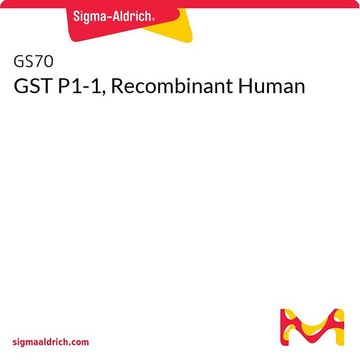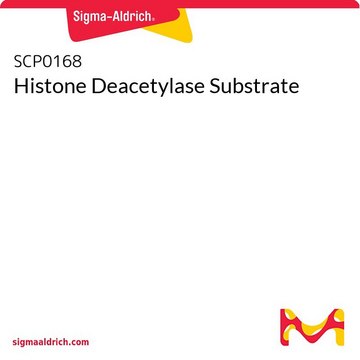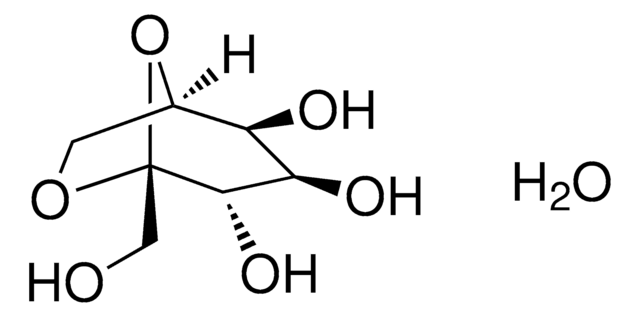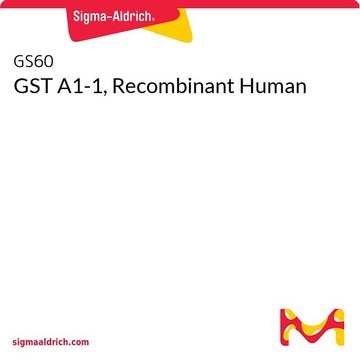SRP6100
GSTM2 human
recombinant, expressed in E. coli, ≥95% (SDS-PAGE)
Synonym(s):
GST4, GSTM, GSTM2-2, GTHMUS, Glutathione S-transferase Mu 2
Sign Into View Organizational & Contract Pricing
All Photos(1)
About This Item
UNSPSC Code:
12352202
NACRES:
NA.32
Recommended Products
biological source
human
recombinant
expressed in E. coli
Assay
≥95% (SDS-PAGE)
form
liquid
potency
<25 units/mg
mol wt
27.9 kDa
packaging
pkg of 100 μg
NCBI accession no.
UniProt accession no.
shipped in
dry ice
storage temp.
−70°C
Gene Information
human ... GSTM2(2946)
General description
Glutathione S-transferase Mu 2 (GSTM2) belongs to the Glutathione S-Transferase (GST) family of proteins. There are 8 families of GST proteins: alpha, kappa, mu, omega, pi, sigma, theta and zeta, each of which is composed of proteins that have various functions throughout the cell. The mu class of enzymes functions in the detoxification of electrophilic compounds, including carcinogens, therapeutic drugs, environmental toxins and products of oxidative stress, by conjugation with glutathione. The genes encoding the mu class of enzymes are structured in a gene cluster on chromosome 1p13.3 and are proven to be highly polymorphic. These genetic variants can change an individual′s susceptibility to carcinogens and toxins as well as have an effect on the toxicity and efficacy of several drugs.
Physical form
0.5 mg/mL solution in 20 mM Tris HCl (pH 8.0) containing 10% glycerol, 0.1 M NaCl and 1 mM DTT.
Preparation Note
Centrifuge the vial prior to opening.
Other Notes
MGSSHHHHHH SSGLVPRGSH MPMTLGYWNI RGLAHSIRLL LEYTDSSYEE KKYTMGDAPD YDRSQWLNEK FKLGLDFPNL PYLIDGTHKI TQSNAILRYI ARKHNLCGES EKEQIREDIL ENQFMDSRMQ LAKLCYDPDF EKLKPEYLQA LPEMLKLYSQ FLGKQPWFLG DKITFVDFIA YDVLERNQVF EPSCLDAFPN LKDFISRFEG LEKISAYMKS SRFLPRPVFT KMAVWGNK
Storage Class Code
11 - Combustible Solids
WGK
WGK 3
Flash Point(F)
Not applicable
Flash Point(C)
Not applicable
Certificates of Analysis (COA)
Search for Certificates of Analysis (COA) by entering the products Lot/Batch Number. Lot and Batch Numbers can be found on a product’s label following the words ‘Lot’ or ‘Batch’.
Already Own This Product?
Find documentation for the products that you have recently purchased in the Document Library.
Sarah Diab et al.
Future medicinal chemistry, 8(3), 271-285 (2016-02-26)
The discovery of small molecules that selectively inhibit Mnks is considered of paramount importance towards deciphering the exact role of these proteins in carcinogenesis and to further validate them as anti-cancer drug targets. However, the dearth of structural information of
Ziyi Yin et al.
Autophagy, 16(5), 900-916 (2019-07-18)
Cells are faced with various stresses during their growth and development, and autophagy is a degradative process in which cells can break down their own components to recycle macromolecules and provide energy under these stresses. For pathogenic fungi that utilize
Our team of scientists has experience in all areas of research including Life Science, Material Science, Chemical Synthesis, Chromatography, Analytical and many others.
Contact Technical Service







